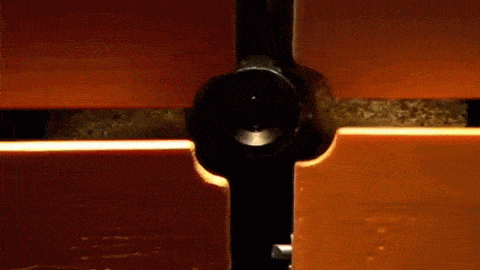Do you have 835 servo motors sitting around? Why not build your own binary wood-pixel-display-device?
Using the same basic concept as a DMD (Digital Micromirror Device) — the heart of all DLP projection technology — an artist created this wooden mirror. It features 835 wood “pixels” which are controlled by servo motors. Each pixel or wood chip can flip 30 degrees down, and 30 degrees up. A series of spot lights shining on the mirror provides lighting so shadows form when the pixels are “off”. The result is quite fascinating.
A small camera mounted in the middle of the display takes a black and white image of whoever (or whatever) is standing in front of the mirror. A bit of image processing later, and the mirror displays what it sees.
So what would you call this thing… a Digital Wood-pixel Device, or DWD for short?
We wonder if the artist is the same guy behind the fur mirror… an equally awesome, but even stranger take on the project.
[via reddit]

















Well… if it’s two-state-only-per-pixel why use servos?
It’s not a 2 state solution, it does grayscale.
A better set of questions is 1) why if it’s art is it a video on youtube instead of vimeo? and 2) Why is it the resolution of our forefathers?
I suspect the answer on both is that it’s from July 2008?
why vimeo instead of youtube?
Vimeo established itself as the choice for art videos, I’m not sure about all the factors involved, but 99% of the cases when there is some art expression project the video is on vimeo.
Whereas if you look for a music video or a cat video you’d better off looking on youtube. Not completely sure how that core audience was established though, I mean I don’t think it’s not allowed to put your pets on vimeo, although with music you have the ever ongoing rights issue and that might give google the leg up in that particular field.
Vimeo had, at least a few years ago (i haven’t compared lately), much better video quality than youtube. I guess if you want to cater to the more serious video crowd you cant destroy the videos :).
Vimeo is banned in many places due to (arguably) offensive content (Indonesia in my case). If your content would be rejected by YouTube, then Vimeo may be the logical choice. But if YouTube will take it, you are likely to reach more viewers.
@drone But for art you want a bit of exclusivity rather than cater to rabble. And the thing with most of the youtube comments being made directly from asylums as part of therapy is also not quite the thing really.
And that wasn’t just sarcasm btw, I saw it on a documentary about an insane asylum, that they let the patient go on the internet as part of therapy, I kid you not. So it’s not just an impression we all get.
The artist is Daniel Rozin and you can see many variations on this idea at his website smoothware.com
…and check out the “penguins” mirror-cum-shadow
Wow this is really cool :)
I saw this at ITP in NY around ’97 I think. It’s pretty cool. It isn’t greyscale; each wood tile has only two states but I imagine that servos are used because they can do the job off the shelf.
The video indicates it’s grayscale, they turn the picture in grayscale too for the process. And obviously it’s easy to partially turn the blocks so why not grayscale?
Gives new meaning to “stuck pixel”. I see several in that video.
This and the fur mirror and many other projects like it are the work of Daniel Rozin.
I was once tasked with repairing one of these wooden mirrors (larger than the one in the video). It had a burned out servo controller board and several stuck servos. Unfortunately the servo controller, PicoPic, is no longer manufactured, and building a suitable replacement is still just out of reach of my skills as a programmer.
For those interested, it’s all run from an off-the-shelf Dell laptop with a USB camera, running custom software that converts the image into serial data to send to the servo controllers. This particular installation used a single USB-RS232 cable with daisy-chained PicoPic boards controlling 20 servos each, and some hefty 5V power supplies to run all those servos. The servos each had a small bolt epoxied to the back of it, and they mounted on pegboard held in place by a nut.
The problem with the installation is people like to come up and push on the wooden blocks, which eventually destroys the servos.
I’ve been following hi work for over a decade now.
I even purchased a license for his Macromedia Director Xtra for Computer Vision.
Mechanical mirrors are his signature work, and he’s even built some using discarded cans and select pieces of garbage :)
Are you sure he uses a servo motor instead of a stepping motor?
The swarovski shop in vienna has a massive wall of these made from semi reflective hexagonal mirrors. It looks really cool and creates “waves” like dropping an object in a pool.
I’ve wanted to build some kind of big mechanical display, but I always get stuck trying to decide on good options for motors/actuators. What are people’s thoughts for cheap, scalable, low power options? I’m thinking of something along the lines of this, the fabric pixel display from a few months ago, that big clock made out of clock faces, or flip dot type displays.
Any success with idea here? I’m thinking about same thing – some kind of mechanical mirror, but the cost is deadly with scale:)
Iirc this was at siggraph a very long time ago.
https://www.siggraph.org/artdesign/gallery/S00/interactive/thumbnail16.html
Saw his peg mirror on youtube, It rotate the mirror segments about an axis perpendicular to the mirror for quieter operation and better greyscale.
https://www.youtube.com/watch?v=dghosA-zI6k